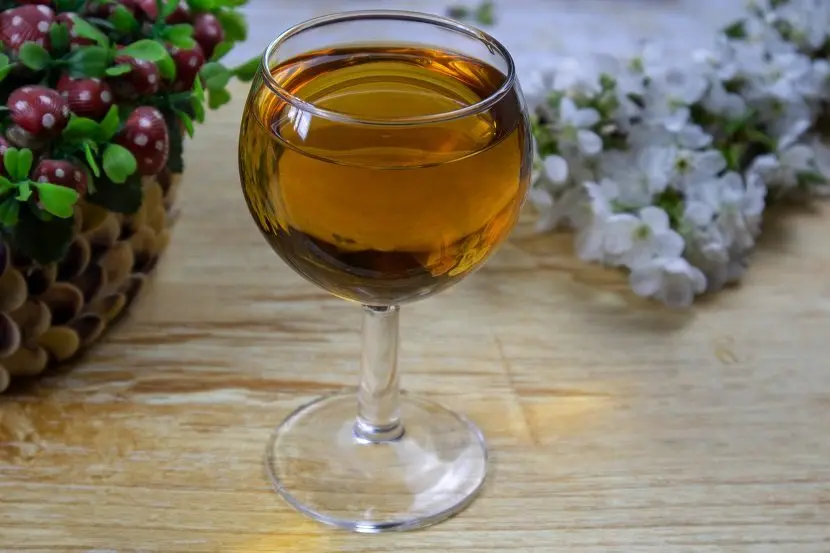Linden blossom wine is remembered for its yellow-amber color, characteristic lime aroma and sweet taste with hints of nectar. Additionally, the drink can be enriched with tones of lemon zest.
For cooking, both fresh and dried lime blossoms are suitable. Fresh flowers should be collected away from roads and industrial sites, preferably before noon in dry, sunny weather. It is good if it rained a day before harvest, but immediately after the rain, the flowers lose their nectar, so the wine is not so fragrant. Dried lime blossom should have a pleasant aroma without mustiness, as the smell of the raw material is transferred to the finished drink.
Ingredients:
- fresh linden flowers – 1 liter jar or half a liter dried;
- water – 4 liters;
- sugar – 1 kg + to taste;
- citric acid – 3 teaspoons (or 3 medium-sized lemons);
- sourdough (wine yeast) – per 5 liters of must.
Citric acid is needed to stabilize the acidity of the must; this positively affects not only the taste, but also the resistance of the wine to diseases. It is better to replace concentrated citric acid with lemons, then the zest can be used to enrich the flavor.
Fermentation requires wine yeast or raisin sourdough (prepare 3-4 days before picking the leaves). If you add ordinary dry or pressed baker’s yeast, then instead of linden wine you get mash with characteristic alcohol tones.
Linden wine recipe
1. Remove leaves, stems, peduncles and other parts from flowers (give bitterness). Do not wash the color to preserve the nectar.
2. Fold the lime blossom into an enamel pan, add 0,5 kg of sugar, pour 3,5 liters of boiling water, stir until the sugar is completely dissolved, then cover and leave for 8 hours.
3. Pour boiling water over the lemons, rinse in running water and wipe dry to remove the preservative from the peel. Gently remove the zest from the fruit with a knife or vegetable peeler – the yellow part of the pulp, without touching the white bitter pulp.
Squeeze the juice from the lemons into the must, then add the zest. In the case of citric acid, simply pour in the powder.
4. Pour in the remaining 0,5 liters of cold unboiled water. Add wine yeast diluted according to the instructions on the bag or pre-prepared raisin sourdough. Mix.
5. Transfer the container with the wort to a dark place at room temperature. Cover with gauze and leave for 3 days. Once every 8-12 hours, stir with a clean hand or a wooden stick, drowning the color that has surfaced in the liquid.
A maximum of a day after the introduction of yeast (usually earlier), signs of fermentation should appear: hissing, foam and a slight sour smell. This means that everything is going well.
6. Strain the wort through 2-3 layers of gauze. Squeeze the flowers dry (no longer needed). Add 250 grams of sugar to the liquid part, mix.
7. Pour the future wine from the lime blossom into a fermentation tank, filling it to a maximum of 75% of the volume, so that there is room for another portion of sugar, foam and carbon dioxide that is released during fermentation.
Install a water seal of any design on the neck. You can limit yourself to a medical glove with a hole pierced by a needle in one of the fingers.

8. Transfer the wort to a dark room with a stable temperature of 18-25 °C.
9. 5 days after installing the water seal, add the remaining sugar – 250 grams. To do this, pour 250 ml of fermenting nectar into a separate container, add sugar, mix. The resulting syrup is poured back into the fermentation tank and closed with a water seal.
Homemade linden wine ferments for 45-55 days. The end of the process is signaled by the absence of gas from the water seal (deflated glove), a layer of loose sediment at the bottom and clarification of the wort.
If fermentation does not stop even 55 days after the installation of a water seal, you need to strain the wine into another container without touching the sediment at the bottom, and then put it to ferment under a water seal at the same temperature.
10. Pour the young fermented wine through a tube without sediment into another container. Taste the drink, optionally sweeten with sugar to taste. You can also increase the strength with alcohol or vodka (add no more than 3% by volume). Fortified wine is better stored, but tougher in taste.
11. Pour the wine into aging tanks, being careful to fill to the top to avoid contact with oxygen. Close hermetically. If sugar was added at the previous stage, keep it under a water seal for the first 7-10 days in case of repeated fermentation.
12. Transfer the wine for maturation to a refrigerator or cellar with a temperature of +2-16 °C. Leave for 4-6 months.
When a precipitate appears with a layer of 2-4 cm, filter the drink by pouring it into another container through a straw. The wine is ready, if the sediment does not fall for several months, then it can be poured into bottles for storage and hermetically sealed.
When stored in a refrigerator or cellar, the shelf life of linden blossom wine is up to 2 years. Fortress – 10-12%.










